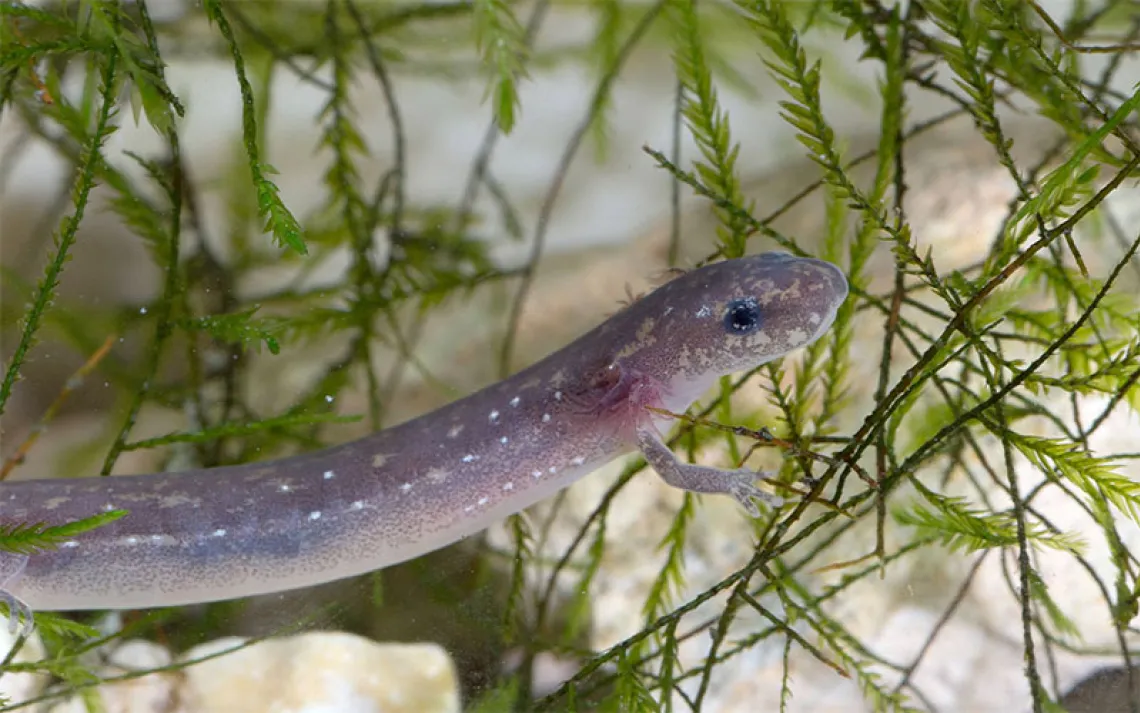The Burning Questions About Spotted Owls and Fire
The effects of a recent megafire in California have ignited a fresh debate about a prominent keystone species

An adult female California spotted owl and owlet in their nest. | Photograph by Sheila Whitmore
In September 2014, an arsonist lit a fire in the Eldorado National Forest in east-central California. The blaze, dubbed the King Fire, quickly grew out of hand, burning for 27 days, torching 12 homes, 68 structures, and 97,000 acres of Sierra Nevada forest.
It was a costly, unnecessary inferno. But the King Fire did have a silver lining: It created a landscape-scale natural experiment for spotted owl researchers. The fire stretched into the Eldorado Density Study Area, an 85,000-acre section of timber company and U.S. Forest Service land where ecologists have been banding, monitoring, and studying California spotted owls, a subspecies of Strix occidentalis, since 1993.
Gavin Jones, a graduate student in wildlife ecology and lead author of a new paper on the fire’s effects on the birds in the journal Frontiers in Ecology and the Environment, says half of the research area experienced a severe burn: The fire destroyed more than 75 percent of the canopy cover, impacting 30 of the 45 owl nests in the study area. The other sections either did not burn or experienced lower-intensity fires, creating a control area. The following year, Jones and his colleagues found that the owls had abandoned 90 percent of their nesting and roosting sites within the severely burned area.
It seems like common sense that owls, spotted or otherwise, would not like severely-burned-out areas. But the subject of forest fires and spotted owls turns out to be complicated and controversial. How well the owls tolerate megafires has implications for a species that has been a conservation flashpoint for over a quarter century. The debate over what to do comes down to two main camps. Some researchers want to thin or restore the forest to prevent megafires that scorch spotted owl habitat. Some environmentalists and biologists say the thinning would harm the owls by reducing the complex habitat they prefer. The debate is just the latest episode in the long-term decline of a species that increasingly needs help.
When the northern spotted owl, the subspecies that lives in the Cascade Range of the Pacific Northwest, was listed as threatened by the Fish and Wildlife service in 1990, it set off a battle known as the Spotted Owl Wars: a conflict between environmentalists who wanted to preserve the owl’s old-growth habitat and the logging companies that were clearcutting swaths of ancient forest. The conflict eventually led to the Northwest Forest Plan, which preserved 20 million acres of forest from logging including critical owl habitat. Environmental and economic pressure gradually closed most of the lumber mills in the area as well, decreasing the impact of logging on the owls.
Despite the protections, however, the spotted owl is still losing ground, with 3.8 percent of the population disappearing each year. Jones says in the Eldorado Study Area the bird has plummeted by 50 percent in the last two decades, while the species has dropped by 77 percent in Washington and 68 percent in Oregon. The newest threats to the bird are an invasion of barred owls, Strix varia, a larger related species from eastern North America that is pushing into the spotted owl habitat. The other threat, depending on who you ask, is megafires caused by fuel buildup in the western forests after a century of fire suppression.
One solution to the megafires is restoration of the forest, which typically means selectively logging trees so fires do not grow as large or burn as hot. For many environmentalists, that is a slippery slope. Since most of the thinning is contracted to logging companies, some see thinning as a backdoor for loggers to access protected forests. Others worry the restoration affects the old, multistory forest habitat spotted owls prefer. Letting fires take their course, they argue, might be a better solution, especially if research shows that the owls stick around after the fires.
Until the King Fire paper, the best evidence of how spotted owls handle intense fires was a study looking at the 2013 Rim Fire in the Stanislaus National Forest, the largest wildfire in Sierra Nevada history. A survey the year after that fire showed that the blaze had minimal impact on the owls. In fact, other studies show that the owls like to hunt in severely burned patches of forest that provide habitat for small mammals.
But Jones says the Rim Fire and the King Fire were very different. For one, the Rim Fire had riparian habitat that survived the burn, and the shape of the blaze had more edge habitat around severely burned areas. The King Fire burned 50 percent of its area severely and in one contiguous path, placing it in the 95th percentile for forest fires. It severely scorched 50,000 acres, leaving behind little or no remnant habitat.
The fact that the fire went through a spotted owl study area also adds an extra layer of information to the research. “We had over 20 years of pre-fire data,” says Jones. “After the burn occurred, we could look at our owl sites and say there was a 90 percent extinction rate at nesting sites versus about 10 percent in a typical year. In my opinion, our study may supercede the types of information collected from the Rim Fire.”
Many scientists who look at the evidence left by the King Fire see thinning as a necessity to prevent megafires. John Bailey, a professor at Oregon State’s College of Forestry who has worked on Forest Service management plans for spotted owl habitat in the northwest, says thinning is the best way to prevent catastrophic fires that destroy habitat. “It’s a no-brainer if you think about the physics of fire and how it spreads,” he says. “If you return the forest to low-fuel conditions, you have more surface fires than crown fires. You have more tree survival, which has less impact on the owls.”
“There are some biologists who don’t see as great a threat from fire, and others who are concerned that fire is a risk. Those who think fire is not a great risk don’t want to do things that might degrade habitat,” says Susan Britting, the executive director of Sierra Forest Legacy, an environmental group that works to protect and restore Sierra Nevada national forests. “If treatments that reduce the risk of fire are a problem themselves, that’s where people start balancing the risk of an owl abandoning its nest in the shorter term versus the benefit of reducing risk of fire for a longer-term benefit.”
Susan Britting says the Rim and King Fire studies are intriguing, but she’s interested in seeing more data. “The birds came back to the area of the Rim Fire in year one, but will they be there in year two?” she says. “What are the results in years three and four? Even in the King Fire, as shrubs and oak sprouts come back, the owls could go back and use those areas differently than they did in year one. For me it’s important to think of the long-term effects.”
Zach Peery, the professor who has led the monitoring of the owls in Eldorado over many years, thinks the path forward is clear. “Almost all the owl territories within the megafire went from occupied to unoccupied,” he says in a press release. “We can now say that megafires have a significant impact on the spotted owl, and so we think that forest restoration through fuel reduction benefits both the forest ecosystem and the spotted owl.”
For his part, Gavin Jones says he doesn’t recommend any particular conservation plan; he’s just collecting information. “What I really want is for management decisions with respect to the spotted owl to be supported by data, and good science,” he says. “This is a highly pivotal moment for the conservation of California spotted owls, and there are a lot of perspectives on the best (and worst) way to do it. Barred owls and fires did not cause this long-term decline; that’s been happening over two decades. There are lots of other issues to deal with, and our paper does not presume to provide answers.”
 The Magazine of The Sierra Club
The Magazine of The Sierra Club



